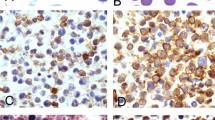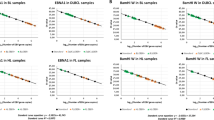Abstract
Primary effusion lymphoma (PEL; also known as body cavity-based lymphoma) is recognized as a new and unique lymphoma entity occurring predominantly, but not exclusively in human immunodeficiency virus (HIV)-seropositive patients with acquired immunodeficiency syndrome (AIDS). PEL grows exclusively in body cavities as serous lymphomatous effusion without evidence of mass disease or dissemination. Their most unique feature is infection with the newly discovered human herpesvirus-8 (HHV-8; also known as Kaposi’s sarcoma-associated herpesvirus), often accompanied by co-infection with Epstein–Barr virus (EBV). A number of continuous lymphoma cell lines have been established from the malignant pleural effusion, ascitic fluid and peripheral blood of patients with AIDS- and non-AIDS-associated PEL. While all cell lines are HHV-8+, about half of them also contain EBV sequences. Stimulation of the cell lines causes switch from latent to lytic HHV-8 infection. The cells are generally negative for T and B cell immunomarkers (except for CD138 suggesting a pre- or terminal plasma cell stage) and positive for some activation and adhesion markers; they are genotypically B cells with their immunoglobulin genes rearranged. Complex, hyperdiploid karyotypes with multiple structural abnormalities are seen in the cell lines examined. No alterations of known proto-oncogenes are detected in PEL, with the exception of BCL-6 mutations occurring in a large percentage of cases. Heterotransplantation of the cell lines into immunodeficient mice leads to the development of lymphomatous effusion and marked angiogenesis. As HHV-8 contains DNA sequences of several protein homologues, the cell lines express various cytokines, cytokine receptors, chemokines, cell cycle and anti-apoptosis modulators which are upregulated upon stimulation. Indeed, some cell lines produce high levels of (human) interleukin-6 and interleukin-10. Taken together, these cell lines represent very important model systems for the elucidation of the pathobiology of PEL; furthermore, the cell lines are extremely useful scientific tools providing a resource to pursue studies of HHV-8-mediated pathogenic mechanisms.
This is a preview of subscription content, access via your institution
Access options
Subscribe to this journal
Receive 12 print issues and online access
$259.00 per year
only $21.58 per issue
Buy this article
- Purchase on Springer Link
- Instant access to full article PDF
Prices may be subject to local taxes which are calculated during checkout
Similar content being viewed by others
Author information
Authors and Affiliations
Rights and permissions
About this article
Cite this article
Drexler, H., Uphoff, C., Gaidano, G. et al. Lymphoma cell lines: in vitro models for the study of HHV-8+ primary effusion lymphomas (body cavity-based lymphomas). Leukemia 12, 1507–1517 (1998). https://doi.org/10.1038/sj.leu.2401160
Received:
Accepted:
Published:
Issue Date:
DOI: https://doi.org/10.1038/sj.leu.2401160
Keywords
This article is cited by
-
1, 25(OH)2 D3 Induces Reactivation and Death of Kaposi’s Sarcoma-Associated Herpesvirus of Primary Effusion Lymphoma cells
Scientific Reports (2017)
-
A role for MALT1 activity in Kaposi’s sarcoma-associated herpes virus latency and growth of primary effusion lymphoma
Leukemia (2017)
-
Establishment of a CD4-positive cell line from an AIDS-related primary effusion lymphoma
International Journal of Hematology (2013)
-
Human herpesvirus-8 (HHV-8) sero-detection and HIV association in Kaposi's sarcoma (KS), non-KS tumors and non-neoplastic conditions
Infectious Agents and Cancer (2008)
-
PS-341 or a combination of arsenic trioxide and interferon-α inhibit growth and induce caspase-dependent apoptosis in KSHV/HHV-8-infected primary effusion lymphoma cells
Leukemia (2007)



